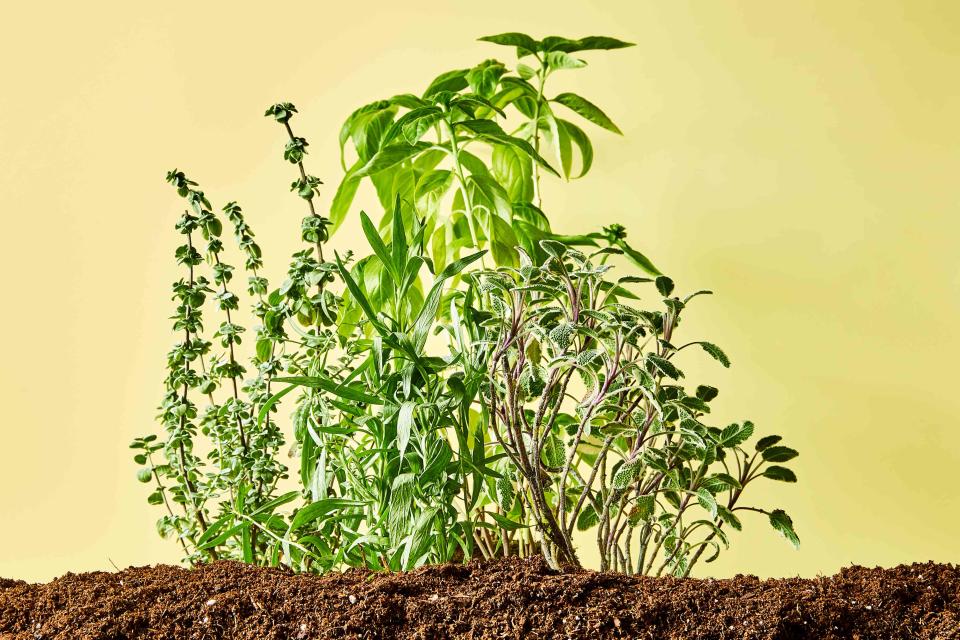Everything You Need to Know to Grow Your Own Herbs
Planting a patch of herbs can offer an easy upgrade to summer cooking.

Kelsey Hansen / Food Styling by Lauren McAnelly / Prop Styling by Joseph Wanek
Every time I cut fresh herbs, I marvel at the scent. I see the same delight from dinner guests when I hand them scissors and ask them to bring me herbs from the garden while I cook. That experience often leads them to start their own herb gardens at home.
Herbs are easy to grow, even for first-time gardeners, and they give you the biggest return for the smallest investment of time, effort, and cost. They can thrive in your backyard garden or in the smallest of spaces — such as in pots on a windowsill — and are fresher and more potent than anything you’ll find at a grocery store or farmers market. (A little goes a long way, too. Two teaspoons of fresh tarragon, for instance, is all you need to flavor a roast chicken.)
Here is everything to keep in mind to maintain a successful herb garden.
Related: The 9 Best Indoor Herb Gardens for Growing Fresh Ingredients Year Round
Give your garden lots of sun and just the right amount of water
Although herbs are not demanding, they do need plenty of sunlight. Many herbs are drought-tolerant and grow in poor, rocky soil. Potted plants require watering every couple of days, while in-ground plants only need to be watered during dry spells. Annual herbs and those that you cut often are usually the only ones that need fertilizer, to replenish the nutrients spent on rapid growth.
Sync up your herb garden with your cooking
When planning my herb garden, I take into consideration each plant’s yield and growth patterns. Dill and cilantro are done once they start to bloom, so I like to have a supply of seeds on hand to start new plants about every six weeks. Since most nurseries only offer herb plants in the spring, I recommend building a collection of seeds. I always go a bit overboard with basil and parsley, as one plant won’t get you very far if you want to make big batches of pesto or tabbouleh.
Know when to move your garden inside
In my Pennsylvania winter, cold-sensitive herbs such as marjoram won’t survive. I find it best to start with a fresh plant every spring, as overwintering is hit or miss. In the winter, my herb garden shrinks to a small AeroGarden hydroponic planter with LED grow lights ($100). It doesn’t produce lavish bunches, but it’s great for fresh sprigs of dill, cilantro, parsley, or basil.
Find the seed catalog that's right for you
With so many seed catalogs to choose from, try to support smaller companies like Kitazawa Seed Co., which specializes in Asian vegetables and herbs. Baker Creek and Truelove Seeds, which both focus on heirloom and open-pollinated seeds, are great sources for rare herbs.
Two ways to preserve your herbs
Freezing: Rosemary, sage, and other herbs with thick leaves can be frozen whole or chopped, while the cold causes thin-leafed herbs like basil to blacken. To prevent this, chop and mix them with oil, or, better yet, freeze them as pesto. I add a pinch of citric acid, which helps preserve the green color.
Drying: Dry herbs indoors, and keep them away from direct sunlight, which makes them fade and lose flavor. I much prefer air-drying over using a dehydrator; it takes longer, but it does not consume energy. Stripping leaves off the stems speeds up the drying process considerably. To avoid mold, herbs need to be crispy-dry and crumble easily before being stored in airtight containers.
For more Food & Wine news, make sure to sign up for our newsletter!
Read the original article on Food & Wine.

